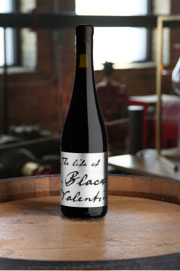- Analysis
- Vineyards
- Vinification and Aging
- Tasting Notes
- Vintage Notes
blankBOTTLE “The Life of a Black Valentine” NV
Wine of Origin
Western Cape
Varietals
Syrah, Cinsault, and Mouvedre
Analysis
Wine Maker: Pieter H. Walser
Alcohol: 13.5%
Owning a farm limits you to the vineyards on your specific farm. I love traveling and experiencing many different areas. I want to make area specific wines, wines that will be ambassadors for areas. I harvest 55 tons from 47 vineyards; 26 different varietals and growing – anything from Fernao Pirez to Cabernet. In the 2015 harvest, I drove 13 000 killometers in 100 days to pick my grapes.
Vineyard-site selection is where all wine begins, and to me personally, one of my most crucial decisions. The Syrah and the Mouvedre came from small vineyards in the Swartland, while the Cinsault came from a vineyard in Darling.
Back in the day, say 35 years ago or so, our more senior winemakers made fabulous wines, which turned out to age so very well. If these wines were stored in the correct way, they turned out to be beautiful, fine and elegant wines with spectacular freshness. The era thereafter though, winemakers aimed for super extracted heavy-oaked wines – more new world style wines. It turned out that the newer era’s wines aged differently. So what exactly did those older winemakers do to their wines that made a 35-year old wine taste so fresh and elegant? Of course there are many angles to this answer, but one possibility I find quite spectacular.
On the labels of these older wines they would mention only one varietal. Apparently this was not the case… In those days the basic pumps, which transported crushed grapes to the tank, struggled when it came to cultivars with super small berries. The amount of juice vs. skin was too little and the skins blocked the pumps. So they needed a lubricant. A consumable one. They made a plan – they would pick Cinsaut the day before harvesting the cultivars with small berries. Cinsaut has huge berries with thin skins, in other words: lots of juice. The crushed Cinsaut would lie in a tank with a little pipe running towards the pump, lubricating the lesser-juiced varietal with Cinsaut to enable the pump to handle the pressure. This had a dual function: firstly the pump would work and secondly they were changing a lower-priced varietal into a higher-priced varietal. Of course they had to keep this secret and subsequently only declared one varietal on the main label. But the one thing they probably didn’t realize at the time was that – and this is the important bit – Cinsaut’s typical characteristics are those of fresh strawberries and cherries, with a lighter tannin structure and older vineyards would produce very “perfumy” wines.
So many of these older wines have a large chunk of Cinsaut in – no-one really knows how much, but there is speculation that it is the Cinsaut indeed that is giving life to these older wines – the elegance and freshness. What confirms the suspicion are wines like old Chateau Libertas. It is a known fact that they used massive amounts of Cinsaut in those wines.
And as the South African wine industry is constantly searching for its own unique identity and style, I think Cinsaut is part of the puzzle.
Being a blend of 3 varietals, the wine has fantastic balance and retains classic varietal expressions from all 3 grapes. The Cinsault provides a bright, fresh, red fruit character (fresh strawberry and bing cherry) while the Syrah adds a bit of blackberry and cracked pepper. The later ripening Mouvedre is notoriously rugged, and provides a bit of muscle to the structure of the wine. The “Life of a Black Valentine” is a sophisticated example of a “Rhone style” blend. It would be best enjoyed with grilled red meat, or braised dishes. This would also make a great cocktailing wine.
This wine is a blend of multiple vintages and is therefore not indicative of either single vintage in the bottle.

